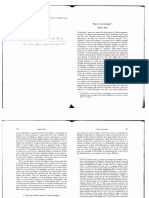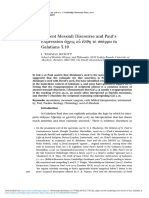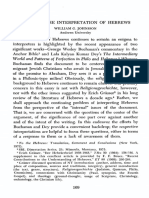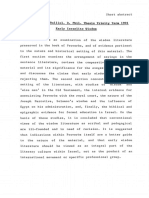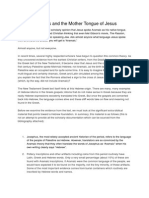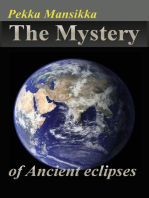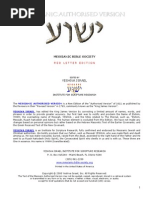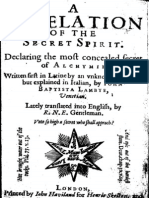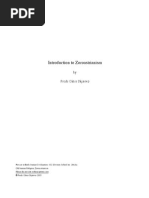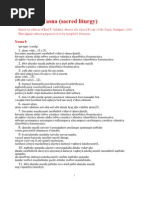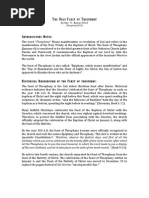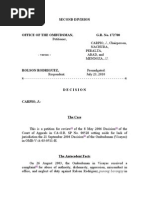Zoroastrianism and Biblical Religion: Charles David Isbell
Zoroastrianism and Biblical Religion: Charles David Isbell
Uploaded by
Gerald MazzarellaCopyright:
Available Formats
Zoroastrianism and Biblical Religion: Charles David Isbell
Zoroastrianism and Biblical Religion: Charles David Isbell
Uploaded by
Gerald MazzarellaOriginal Title
Copyright
Available Formats
Share this document
Did you find this document useful?
Is this content inappropriate?
Copyright:
Available Formats
Zoroastrianism and Biblical Religion: Charles David Isbell
Zoroastrianism and Biblical Religion: Charles David Isbell
Uploaded by
Gerald MazzarellaCopyright:
Available Formats
ZOROASTRIANISM AND BIBLICAL RELIGION
CHARLES DAVID ISBELL In two previous articles, I have addressed the current debate among biblical scholars about the historical reliability of the Bible. In "Minimalism: The 1 Debate Continues: Part I" I surveyed briefly the arguments upon which the proponents of Minimalism rely in efforts to defend their theory that the literature of the Hebrew Bible is essentially a product of the Persian era or the even later Greek period. I offered the opinion that if one presumes that the Bible was composed as a political document to induce the Persian government to grant leadership to a particular group, the story of the Bible is 2 ill suited to such a purpose. In "Minimalism: The Debate Continues: Part II" I offered a critical review of one of the major books written by the influential minimalist Thomas Thompson. In this article, I shall offer a cursory survey of the questions of dependence, borrowing, and influence between Zoroastrianism and biblical religion.
BIBLICAL LITERATURE AND OUTSIDE INFLUENCES
For the past 200 years, scholars of Scripture have recognized the literary relationships between biblical narratives and various extra-biblical sources. Rich archaeological recoveries have illustrated that the literary format of the Bible belongs to a diverse family of ancient Mediterranean literary traditions from Mesopotamia, Egypt, Asia Minor, Syria-Palestine, and Phoenicia. Here I have chosen to offer illustrations from only two of these sources, Egypt and Mesopotamia, and to give only a brief sample of the rich cultural exchanges 3 that these two mighty lands had with the people of the Bible. Despite any differences in the theological arguments being made by the respective accounts, it is difficult to avoid the literary relationship between biblical narratives like stories about Creation and the Flood and similar accounts now recovered from Babylonian and other Mesopotamian sources. One of the most striking examples occurs in the accounts of a great
Charles Isbell has a Ph.D. in Hebrew and Biblical Studies from Brandeis University and has written seven books and over 100 articles on biblical and liturgical themes. He is currently a professor of Hebrew and Judaic studies at Louisiana State University and was recently Scholar in Residence at Temple B'nai Israel in Baton Rouge, Louisiana.
CHARLES DAVID ISBELL
and universal Flood found both in the Bible and in Sumerian and Babylonian 4 sources. A somewhat different situation exists with respect to the story of the Israelites in Egypt. A careful reading of the Hebrew text of Genesis 38 Exodus 14 reveals what Professor Nahum Sarna has accurately described as 5 "Egyptian coloration." That is, the Hebrew text of the Bible contains quite a 6 few clues that its author was familiar with Egyptian language and culture. 1. Several personal names are classical Egyptian, including not only Phinehas [p'nhsy, "the Nubian"], Asenath [dd-n.f('I)p-'nh, "God speaks"], Potiphera [P3-di-P3R', "he whom (sun-god) Pre has given"], Miriam [derived from the Egyptian word mer, "love"], but even the name of the Hebrew hero himself, Moses [ms, "a son"]. 2. Place names like Ramses [P(r) R'mss] and Pithom [P(r)'Itm] are classical 7 Egyptian expressions for "the house [dynasty] of Ramses" and "the house [Temple] of Atum. 3. The unusual expression "abrekh" found only in Genesis 41:43, is described as the exclamation used to hail Joseph riding on his chariot after his elevation to Viceroy of Egypt. Jewish exegetes like Ibn Ezra attempted to relate the word to the root berekh; that is, a hiph'il form that would mean something like "bend the knee." But a simpler explanation traces the word to the Egyptian expression "'b-r.k," which means "Attention!" While readers of the biblical Exodus narrative are left to ponder the precise time and nature of international contact between the two cultures, they are also left with the clear impression that many things Egyptian influenced the literary form of the Hebrew text.
BIBLICAL LITERATURE AND PERSIAN VOCABULARY
Given the Babylonian and/or Egyptian literary influences on some biblical narratives, it is fair to ask whether there might exist anything comparable with respect to Persian literature, specifically a biblical borrowing of Persian vocabulary and/or personal names. And the first thing that comes to mind is that several biblical books do in fact exhibit Persian loan words. EzraNehemiah, Esther, Daniel, Chronicles, and the extra-canonical Book of Tobit all betray the time and circumstances of their composition during and after the Persian era (fifth-fourth centuries BCE) by the presence of Persian
JEWISH BIBLE QUARTERLY
ZOROASTRIAN INFLUENCE ON BIBLICAL RELIGION
loanwords, by reference to Iranian or Zoroastrian entities, and by reference to Persian political structure and practices. The second point to be made is that not a single Persian loanword is known throughout the entirety of the Hebrew Torah, and one searches in vain for any hint of the existence of a Persian Empire. On any fair reading, this should require an interpreter to ask how the great Persian Empire could fail to influence the most fundamental text of Judaism. If the Torah were composed during the Persian era, under the influence of Persian culture and religion, or even if the redactors of the Torah simply knew and were conversant with the Persian language, how could such a lacuna occur? Could a modern author compose a story purportedly set in the time of World War I and never, not even one time, make a reference to any event later than 1919? Could that same modern author go back even farther in time and write about the Middle Ages without one slip of his pen, one tiny word that came into English only within the past 500 years or so? This seems to me as unlikely as the idea that 8 a post-exilic biblical author could retroject his storyline back over 1000 years to the Torah narratives without once betraying himself via anything Persian in vocabulary, historical reference, or syntactic structure. Even if we admit a later editing of pentateuchal narratives sometime in the late eighth or early seventh century, we would have to argue for a conscious archaizing on the part of the presumed exilic tradents (Massoretes). Yet even if the pentateuchal editors worked this close in time to the insinuation of the Persian Empire into the mainstream of ancient Near Eastern political life, we still cannot find clear pentateuchal references to Persian customs and mores. These two points, taken together, are quite in line with what virtually all modern biblical scholars understand about the composition of late biblical books. Biblical books containing Persian loanwords reflect the Persian era, the time of open contact between the people of Judah and the Persian Empire beginning in the middle of the sixth century BCE. I believe that the burden of proof rests upon those who argue for a Persian-Hellenistic provenance for virtually all of the Bible. They must explain why the biblical books in which comparable loanwords are absent could have been composed during the Persian period without any Persian linguistic markers. What about the Torah? The standard scholarly opinion is that the document brought from Babylon to Jerusalem in the fifth century BCE by Ezra was
Vol. 34, No. 3, 2006
CHARLES DAVID ISBELL
essentially what we read today in the Hebrew Bible. Had it been composed during the early decades of Persian rule (ca. 540-500 BCE), surely its authors would have been betrayed by at least one or two Persian words, at least one Persian cultural reference! But they are simply not there in the text of the Torah. And the simplest explanation for this fact is that the Torah had already been composed before Persia became an influence in Jewish life.
ZOROASTRIANISM AND BIBLICAL THEOLOGY
One of the strongest assertions being made by the minimalist school of thought is that Zoroastrian influence on biblical theology is both obvious and 9 widespread throughout the Bible. Included among the influenced doctrines are biblical teachings about a variety of subjects. In other words, even though specific Persian vocabulary may be missing, broad theological doctrines in Persia surely influenced some of the most fundamental ideas of the biblical authors. But a careful examination of these subjects does not support such sweeping claims. 1. Satan. The biblical term "satan" derives from a common Semitic root meaning "to oppose, to obstruct." In Numbers 22, it is the "messenger of God" who stands in the path of Balaam, functioning "as an opponent" l'saten [to obstruct] his passage. This is surely not "a distinctive demonic figure, 10 opposed to God and responsible for all evil." In particular, this satan is not a divine or semi-divine entity, virtually co-equal with God. In Psalm 109:6, a satan is to be appointed to act as a court appointed adversary who will judge the accusers of the psalmist to be guilty. Again it must be emphasized that in none of these places is satan either a proper name or a super-powerful being of any kind. Satan also occurs in three post-exilic biblical texts, each time describing a member of the heavenly entourage who plays the role of an ad hoc accuser. Thus in the prose prologue to the Book of Job 1-2, one member of the divine entourage is selected to question the integrity of Job. This member has no independent power, but acts only within the boundaries set for him by God, and is required to obtain permission from God before acting negatively against Job. In Zechariah 3:1, as part of the prophet's larger vision of a Divine tribunal, "the Satan [ha'satan, again not a proper name]" is stationed at the right hand
JEWISH BIBLE QUARTERLY
ZOROASTRIAN INFLUENCE ON BIBLICAL RELIGION
of the High Priest Joshua, who is being arraigned before the "messenger of God" to determine his fitness for office. In the vision, this adversary is assigned a very specific function, "l'satno [to accuse him]." Once again, the total control of God is underscored, and the following verse describes God 11 rebuking this accuser, thus rejecting his arguments made against Joshua. Joshua is thereupon declared "clean," and is given ritually pure garments to wear (v. 5). We read in I Chronicles 21:1 that Satan incited David to take a census. Again, the incitement [va'yaset] came not from God but from satan. Because satan in Chronicles does exactly what God does in Samuel, it seems clear that here too satan is acting within the purview of God, not on his own initiative. These biblical passages about satan must be viewed in the context of the Zoroastrian doctrine of dualism. Zoroastrianism had no philosophical 12 "problem of evil." For its followers, there was not one god, but two. Ahura13 mazda was totally good, pure spirit, and incapable of evil. But existing alongside of Ahura-mazda was another being who was also eternal and 14 uncreated, the totally evil and material Ahrimam. Just as "good" entered the world via Ahura-mazda, so "evil" entered through Ahrimam. A Zoroastrian 15 could say, "the devil made me do it," but a biblical author could not, and did not. To the contrary, Job himself could be made to ask rhetorically, 'Should we accept good from God and not accept evil?' (2.10), and asserted that his misfortune had come, not from some malevolent force on the loose in an unfriendly universe, but from God alone: 'God gave, and God has taken' (1:21). In each biblical use of satan, biblical theologians, bound to a monotheistic worldview, could choose from among various literary frameworks through which evil things could enter the world: The trials of Job, the indictment of Joshua, the vengeful inducement of King David to take a census. But always the framework delineates the role of each player, and always satan remains under the total control of God, able to function only as he is commanded by 16 God. That biblical satan could be linked with the Zoroastrian Ahrimam is an unnecessary and textually unfounded hypothesis. 2. Creation: More than 40 years ago, the well-known scholar of rabbinic and New Testament literature Morton Smith argued that Isaiah 40-45 reflects
Vol. 34, No. 3, 2006
CHARLES DAVID ISBELL
the teaching to be found in Gathic (old Persian) texts, and is therefore to be 17 viewed as influenced by them. Smith's focus was actually Isaiah 45:7, where God is quoted as asserting, 'I form light and create darkness.' For Smith, the word-pair "light-darkness" was a reflection of Persian/Zoroastrian dualism. Yet word pairs of this sort occur frequently in the Bible, functioning jointly as a merismus (that is, a combination of opposites to express the single idea of totality). Pairs of this kind (heaven and earth, good and evil, male and female) are poetic ways of saying "everything." What Smith and his followers also overlooked is the fact that the idea of Creation found in Isaiah 40-45 does not refer only to the original Creation of the cosmos but deals instead with a new creative act of God in restoring exiled Judahites to their former country. In Jewish worship, these Isaianic creation hymns are seen clearly to point back to the Creation epic of Genesis, and Isaiah 42:5-43:10 serves as the Haftarah to Genesis (Parshat Bereshit). The unnamed prophet, living in 18 sixth-century Babylon and openly aware of the career of Cyrus the Persian, extols the absolute oneness of God, Who alone is Creator (note bara in 42:5 and 43:7, and yatzar in 43:7), Who has absolutely no rival, and certainly no counterpart comparable to Ahrimam. Isaiah further affirms that anyone claiming an idol or molten image [pesel] as a deity will be put to utter shame (42:17). In short, the dependence of the prophet on the Genesis account is transparent, but his language functions metaphorically to affirm his conviction that the Sovereign of the original Creation was the Guarantor of the coming restoration of the Judahites. For such a prophetic purpose, appeals to a Persian model have no substance. 3. Cultic Purity: Noted Zoroastrian scholar Mary Boyce has floated yet another claim. Citing Zoroastrian purity laws which attest abhorrence of dead bodies and female menstruation, Boyce concludes that Nehemiah's (and thus biblical) concern with matters of purity could be traced to his acquaintance 19 with the cultic practices he observed in his role as cupbearer to Artaxerxes I. Here again, the circularity of the argument is striking. Boyce is forced to ignore the Levitical legislation that was surely earlier than Nehemiah and far 20 more detailed. She is also required to assume that the Persian monarch was a strict Zoroastrian as the religion came to be defined in much later texts, and that he would have forced all of his officers to abide by his religion. This is
JEWISH BIBLE QUARTERLY
ZOROASTRIAN INFLUENCE ON BIBLICAL RELIGION
certainly not the benevolent Artaxerxes portrayed in Nehemiah 2:1-8 giving ready permission to his courtier to return to Jerusalem, even paying for timbers necessary for the beams of the Temple fortress. The criticism of Boyce made by James Barr is precisely on point: "Professor Boyce's reconstructions of what may have happened . . . are often highly 21 adventurous." 4. Demons and Angels: Here again Boyce has made a startling assertion: As the Jews came to venerate The Lord as the all-powerful Creator, they appear to have felt an increasing need to acknowledge lesser immortal beings, his servants, who would bridge the vast gulf that now opened between him and his 22 worshippers. Boyce traces this need to what she sees as the Jewish belief in angels and demons, attested in the phrase the host of the heavens, the earliest reference to which she cites as Isaiah 24:21. Based upon her interpretation of this phrase, Boyce argues that Jews produced a highly developed angelology, 23 which "reflects to a large extent Zoroastrian belief in the yazatas." What must be noted is that the yazatas were not servants of or subject to Ahuramazda; they were individual deities in the Zoroastrian pantheon who themselves received the worship of human subjects. Two points emerge. First, there are indications of a simple angelology in the Pentateuch. The "messengers [malachim]" who converse with Abraham (Gen. 18, 19), Jacob (Ch. 28), or Moses (Ex. 3), are human in appearance, apparently speak fluent Hebrew [!], and are never worshipped. That is, 24 envoys sent by God to deliver a message, or lesser beings in His entourage, are radically different from minor Zoroastrian deities. Second, even the more highly developed angelology of later texts like Zechariah 1-6 do not elevate any being to the stature of a deity, no matter how minor, to be worshipped. Thus even in a later biblical era, the picture of God sending out emissaries and Zoroastrian deities who were worshipped are two very different ideas. Likewise, the biblical picture of God in the Book of Job presiding over a council of lesser beings in His heavenly entourage, none of whom were divine, does not match at all with the yazatas in Zoroastrianism. 5. Final Judgment, Heaven, and Hell: At death, according to the tenets of Zoroastrianism, the souls of all persons ascend to the summit of Mount Hara
Vol. 34, No. 3, 2006
CHARLES DAVID ISBELL
where the good and bad of each soul are weighed in balances. If the good outweighs the bad, the soul crosses a cosmic bridge and passes into heaven. If the bad outweighs the good, the bridge collapses and the soul plunges down into hell. Both the blessed and the damned continue to exist until the time of the general resurrection of bodies and the reincarnation of departed spirits so that they too could take part in the final judgment. The ultimate judicial test was an ordeal by fire, and Zoroaster also saw the Last Judgment to be enacted through such an ordeal, but on a cosmic scale. Molten metal would flow out from the mountains to form a burning river; and the reincarnated (sic!) souls, together with those still living, would pass through it in the 25 flesh. Divine intervention will save the good souls, while the bad souls will perish entirely on this final day. Since evil will have become extinct, history will come to an end, good souls will receive immortal bodies and will live forever in the re-perfected earth ruled over by Ahura-mazda. It is true that the Bible includes several references to a fiery ordeal by which evil is purified or destroyed. Isaiah 1:25 speaks of God purifying Jerusalem by fire, and the root tzaref [to smelt, refine] is used twice by Isaiah of Babylon (40:19; 41:7). Malachi 3:1-3 vividly describes God Himself as like the fire of a refiner, who will sit as a smelter and purifier of silver, and He will purify the Levites and refine them like gold and silver. But this is radically different from the ordeal by fire described in Zoroastrianism. Evil is destroyed, to be sure, but there is no hint of a hell of fire into which people are plunged because of their sinfulness. The purpose of fire in the Bible is to destroy the acts of wickedness that people commit, not to destroy the people themselves. There is a fundamental difference between purifying a person by purging him from "sin," and destroying that person for all eternity because he has not met a religious standard. The celebrated German orientalist Rudolf Mayer concluded that the fiery ordeal of Zoroastrianism 26 and the fiery wrath of God in the Bible are radically different. The famous incident of Korah in Numbers 16 furnishes another example of clear differences between the Zoroastrian fiery ordeal and biblical fire. Those who opposed Moses went down alive into Sheol, . . . the earth closed over them, and they vanished from the midst of the congregation (16:33). Sheol, as
JEWISH BIBLE QUARTERLY
ZOROASTRIAN INFLUENCE ON BIBLICAL RELIGION
its very name implies, was an abode of great uncertainty, a question mark implying Israelite lack of confidence that they knew what came after death. This is the exact opposite of the Zoroastrian doctrine that explains in great detail precisely what happens in the next life, both to the good and to the bad. The pagan background of this Hebrew imagery is not Persian, but is well known from the Ugaritic texts where death [mot] is one of the gods. In the words of Jacob Milgrom, "Perhaps it is the pagan background of the imagery that this verse tries to counter by emphasizing that it is solely the creative act 27 of the Lord that is responsible for the activity of the earth." 6. Resurrection: In response to the assertion of numerous scholars that Zoroastrianism provides the background to the biblical doctrine of the resurrection of the body, it is necessary once again to note the fundamental differences between the two systems with respect to this particular issue. It is commonly acknowledged that the biblical concept of resurrection is limited to a few references only, all from later sources, none including anything like a detailed exposition of the exact nature of the process. Daniel 12:1-3 is the locus classicus for all discussions of biblical resurrection. Yet even this passage offers only a simple statement, and does not even come close to answering basic questions about the how, the why, the when of human resurrection. It is a staunch statement of faith in the future, appropriately cited in the well-known funeral song "El Maleh Rahamim" to express the hope that the departed loved one will "shine brightly like the glow of the firmament," and such a hope has brought comfort to countless millions of Jews at grave sites. But nothing specific about resurrection is explained in the biblical passage, and Jewish discussions about resurrection have continued in the post-biblical era to this very day. Still, as Eichrodt insists, "the idea that the eschatological resurrection hope, in the form attested in the Old Testament, was influenced by Persian conceptions, can be shown by any 28 reasonably detailed comparison to be inadmissable."
THE DATING OF BIBLICAL AND ZOROASTRIAN TEXTS
To this point, I have spoken of Persian or Zoroastrian matters as if they themselves were composed during and reflective of the Persian era of contact with the exiled Judahites (fifth-fourth centuries BCE). But they were not. In fact, the severe deficiencies in the written sources of Zoroastrianism make
Vol. 34, No. 3, 2006
CHARLES DAVID ISBELL
accurate analysis virtually impossible. No modern scholar dates Zoroaster 29 earlier than ca. 1400 BCE, and while both Arabic and Avestan traditions date Zoroaster to the sixth-fifth centuries BCE, most scholars are more comfortable with a date between the two extremes; the date 1000 BCE is most widely presumed. But scholars of written literature are faced with a problem that has yet to be solved. No written materials are linked to the era of Zoroaster regardless of when he lived, and even scholars who argue that early Iranian texts are linked to ca. 1000 BCE, admit that these Gths ["hymns" (of Zoroaster)] are so difficult that their meaning can be grasped, 30 "only with the help of the later Zoroastrian scriptures." Iranian priests of the early first millennium actually rejected the use of writing for their holy beliefs, and the fact is that these beliefs existed only in oral form until the sixth century CE! And yet these written texts are the ones which Persian scholars are required to use in interpreting the teachings of Zoroaster, who lived between 1000 and 2000 years earlier. Shaul Shaked has framed the matter accurately and concisely: All arguments about possible contacts between Israel and Iran come to the stumbling block of the problem of chronology. All detailed accounts of any aspect of Zoroastrian theology exist no earlier than in books compiled during the Sassanian period [third31 seventh centuries CE] or later, after the Arab conquest of Iran. In short, the texts being examined in comparison to the Bible were written more than 1000 years later than the Persia with which Judahites came into contact. Still, the larger problem with the written sources of Zoroastrianism is not their late date of composition, but rather the fact that even these late written sources present very few close parallels to biblical ideas. In light of this chronological difficulty, it would seem to make more sense to compare Zoroastrian religious texts with talmudic literature. And even here, Neusner, the scholar with the greatest knowledge of Babylonia during the era of Sassanid rule, has concluded that what the rabbis of the Talmud 32 knew of Zoroastrianism amounted to virtually nothing at all.
CONCLUSION
JEWISH BIBLE QUARTERLY
ZOROASTRIAN INFLUENCE ON BIBLICAL RELIGION
Jews are surely familiar with the idea of an oral tradition that crosses several centuries of time before being reduced to writing. And it is not my purpose to speak ill of another religion, Zoroastrianism or any other. Yet, it seems obvious that the claims for Zoroastrian influence on biblical doctrines have been vastly overstated. With specific reference to Minimalism, the purpose of this article has been simple. Minimalists have made it clear that for them, the standard used to evaluate the historical reliability of a biblical story is its verification by an external physical source. Using their own criterion, it should follow that the use of late, very late, written sources of Persian theological tenets must be ruled out as evidence of any significance 33 whatsoever regarding biblical texts.
NOTES 1. Jewish Bible Quarterly XXXII:3 (July 2004) pp. 143-147. 2. Jewish Bible Quarterly XXXII:4 (Oct. 2004) pp. 211-223. 3. For additional materials of the sort mentioned here, readers may consult the highly readable and useful work of Victor H. Matthews and Don C. Benjamin, Old Testament Parallels: Laws and Stories from the Ancient Near East (New York: Paulist Press, Second Edition, 1997). 4. The most well known and best preserved is in the Gilgamesh Epic. 5. "Book of Exodus," Anchor Bible Dictionary [ABD] II, 697. See Sarna's survey of these Egyptian hues on pages 697-698. 6. I am giving only a few examples here to illustrate the point. Readers interested in a complete discussion may consult K. A. Kitchen, On the Reliability of the Old Testament (Grand Rapids: Eerdmans, 2003), especially Chapter 6, pp. 241-312. But see my review of Kitchen at http://www.bibleinterp.com/ Also useful is James K. Hoffmeier's Israel in Egypt: The Evidence for the Authenticity of the Exodus Tradition (Oxford: Oxford University Press, 1996). 7. Constructed by Ramses II (13th century BCE) in the eastern part of the Nile Delta. 8. I am speaking of the ability to do this, not whether anyone would have wanted to try, the issue addressed in my two earlier articles. 9. For documentation, see Edwin M. Yamauchi, Persia and the Bible (Grand Rapids: Baker Books, 1990) pp. 458-466. In what follows, I am indebted to Yamauchi for many references. 10. T. H. Gaster, "Satan," Interpreter's Dictionary of the Bible [IDB], 4, 224. For a complete and more recent discussion of "Satan," see Peggy Day, An Adversary in Heaven: Satan in the Hebrew Bible (Atlanta: Scholars Press, 1988, Harvard Semitic Monographs 43). 11. Zechariah 3:2 became a favorite among Jewish magicians of the later Sassanid era, and they cited it often in incantations written to protect their clients. See Charles D. Isbell, Corpus of the Aramaic Magical Incantation Bowls (Missoula: SBL Dissertation Series, 1974). 12. Mary Boyce [ABD VI, 1169] has argued that the ancient Iranians acknowledged three lords (Ahuras) rather than two. 13. Meaning the "Good Lord." Vol. 34, No. 3, 2006
CHARLES DAVID ISBELL
14. Ahrimam is the Pahlavi (third-ninth centuries CE, Parthian) name for Old East Iranian Angra Mainyu, the "Evil Spirit." 15, The English word "devil" derives from Persian daeva, used in classical Persian texts to describe the ancient war gods created by Ahrimam as counterforces of evil opposing good. 16. Sassanid era (third-seventh centuries CE) Jewish magical texts mention the word both in the masculine and in the feminine, both singular and plural. 17. "II Isaiah and the Persians," Journal of the American Oriental Society 83 (1963) pp. 415-421. 18. See Lisbeth S. Fried, "Cyrus the Messiah? The Historical Background to Isaiah 45:1," Harvard Theological Review 95:4 (2002) pp. 373-393. 19. ABD VI, 1169 20. On the dating of the priestly legislation, see the convenient summary by Jacob Milgrom, "Priestly ('P') Source," ABD, V, 454-461. In the excellent bibliography listed by Milgrom, note especially the works of Avi Hurvitz. 21. "The Question of Religious Influence: The Case of Zoroastrianism, Judaism, and Christianity," Journal of the American Academy of Religion 53 (1985) p. 229 note 47. It should be noted that the influence of Boyce upon biblical minimalists has never been made explicit, and she is not cited in the major works of the school. But it is clear that her positions regarding the relationship between Zoroastrian and biblical texts are widely held among those who presume the late, Persian dating of biblical literature. 22. A History of Zoroastrianism, Vol. II (Leiden: E. J. Brill, 1972) p. 195. 23. Boyce, History, II, 195. 24. The root of the word "messenger" is "la'akh," an older Semitic root meaning "to go." It is not related to the root "melekh [to be king]." 25. "Zoroaster, Zoroastrianism," ABD, Vol. VI, 1170. 26. Rudolph Mayer, Die biblische Vorstellung vom Weltenbrand (Bonn: Orientalisches Seminar der Universitat Bonn, 1956). 27. See on the passage the interpretation of Milgrom, The JPS Torah Commentary: Numbers (New York: Jewish Publication Society, 1990) pp. 129-138. 28. Walther Eichrodt, Theology of the Old Testament, Vol. 2, 4th Edition (Philadelphia: Westminster Press, 1961) p. 517. 29. Derived from Middle Persian "awastag [tradition]." The term Avesta is also the name given to the entire collection of Zoroastrian sacred writings. 30. Boyce, ABD VI, 1168. 31. Shaul Shaked, "Qumran and Iran-Further Considerations," Israel Oriental Studies 2 (1972) p. 443. 32. Jacob Neusner, A History of the Jews in Babylonia (Leiden: E. J. Brill, 1969), especially Volume 4. See also his Judaism, Christianity and Zoroastrianism in Talmudic Babylon (Lanham: University Press of America, 1986). 33. My friend and colleague at Louisiana State University Professor Stuart Irvine read an earlier draft of this paper and made numerous helpful suggestions. I offer my thanks to him here.
JEWISH BIBLE QUARTERLY
You might also like
- An Egyptian Source For Gen 1 - AtwellDocument38 pagesAn Egyptian Source For Gen 1 - AtwellRupert84100% (1)
- Eusebius Preparation For The Gospel PDFDocument2 pagesEusebius Preparation For The Gospel PDFMichael0% (2)
- Zeitgeist Source Book p1Document109 pagesZeitgeist Source Book p1thing21290100% (1)
- TeraphimDocument3 pagesTeraphimAlexis ValarNo ratings yet
- 2004 - Charles Quarles - Jesus As Mamzer - Review of Rabbi Jesus' by Bruce ChiltonDocument13 pages2004 - Charles Quarles - Jesus As Mamzer - Review of Rabbi Jesus' by Bruce Chiltonbuster301168No ratings yet
- 2 Essence Accident and Race 1984Document12 pages2 Essence Accident and Race 1984NeguePower LMPNo ratings yet
- H W The Rape of Eve and Its Spiritual Connotations in Early Jewish and Gnostic LiteratureDocument33 pagesH W The Rape of Eve and Its Spiritual Connotations in Early Jewish and Gnostic LiteratureNicole L TateNo ratings yet
- Different Competing Creation AccountsDocument7 pagesDifferent Competing Creation Accountshubertgoh58No ratings yet
- Joel Wolowelsky - Divine Literature and Human Language Reading The Flood StoryDocument14 pagesJoel Wolowelsky - Divine Literature and Human Language Reading The Flood StoryאלברטורודריגסNo ratings yet
- The Iconography of Bes With Particular Reference To The Cypriot EvidenceDocument28 pagesThe Iconography of Bes With Particular Reference To The Cypriot Evidencekl_studyNo ratings yet
- Visions in Book of EzraDocument26 pagesVisions in Book of EzraDonna HallNo ratings yet
- Stephen Menn - Plato's SoteriologyDocument14 pagesStephen Menn - Plato's SoteriologyChristian Goeritz AlvarezNo ratings yet
- The Angelology of The Non-Canonical Jewish Apocalypses PDFDocument17 pagesThe Angelology of The Non-Canonical Jewish Apocalypses PDFManticora Veneranda100% (1)
- Robinson. Texts and Studies: Contributions To Biblical and Patristic Literature. Volume 5.Document694 pagesRobinson. Texts and Studies: Contributions To Biblical and Patristic Literature. Volume 5.Patrologia Latina, Graeca et OrientalisNo ratings yet
- MonoteismoDocument36 pagesMonoteismomigang100% (1)
- Ancient Messiah Discourse and Paul's Expression in Galatians 3.19Document14 pagesAncient Messiah Discourse and Paul's Expression in Galatians 3.19farax1720No ratings yet
- Ophite Gnosticism, Sethianism and The Nag Hammadi Library: Vigiliae 59,3 - 799 - 235-263 6/28/05 2:55 PM Page 235Document30 pagesOphite Gnosticism, Sethianism and The Nag Hammadi Library: Vigiliae 59,3 - 799 - 235-263 6/28/05 2:55 PM Page 235PrendasNo ratings yet
- Enlil Is Not Yahweh Anu Is - Let's Be Done With The Lie Once and For All!Document7 pagesEnlil Is Not Yahweh Anu Is - Let's Be Done With The Lie Once and For All!Sudalaimanian Jeyakodi100% (1)
- Ancient Near Eastern Influence On Greek WritingsDocument2 pagesAncient Near Eastern Influence On Greek Writingsjiatrou6350100% (1)
- Chiera, Edward & Ephraim A Speiser, A New Factor in The History of The Ancient EastDocument19 pagesChiera, Edward & Ephraim A Speiser, A New Factor in The History of The Ancient Eastkalyanaraman7No ratings yet
- Gilgamesh UgaritDocument18 pagesGilgamesh UgaritDario Giansanti100% (1)
- Andrei Orlov Metatron As Prince of WorldDocument3 pagesAndrei Orlov Metatron As Prince of Worldbooksreligion100% (1)
- Andrei Orlov Yom Kippur in Apocalypse of AbrahamDocument33 pagesAndrei Orlov Yom Kippur in Apocalypse of AbrahambooksreligionNo ratings yet
- Knopper S 2005Document29 pagesKnopper S 2005Bholanath MajhiNo ratings yet
- Basilides's Gospel and Exegetica (Treatises) : Vigiliae Christianae June 2005Document22 pagesBasilides's Gospel and Exegetica (Treatises) : Vigiliae Christianae June 2005Jamal DookhyNo ratings yet
- Allison - Resurrection of JesusDocument17 pagesAllison - Resurrection of JesusDanilson LopesNo ratings yet
- What Is A Variant? Announcing A Dead Sea Scrolls Fragment of DeuteronomyDocument10 pagesWhat Is A Variant? Announcing A Dead Sea Scrolls Fragment of DeuteronomyZachary KleimanNo ratings yet
- Johnsson Perfection - Issues in The Interpretation of Hebrews PDFDocument19 pagesJohnsson Perfection - Issues in The Interpretation of Hebrews PDFpr_isaacNo ratings yet
- John Qumran and The Dead Sea Scrolls Sixty Years of Discovery and Debate Mary L. Coloe All Chapter Instant DownloadDocument84 pagesJohn Qumran and The Dead Sea Scrolls Sixty Years of Discovery and Debate Mary L. Coloe All Chapter Instant Downloadmicarjecy74100% (11)
- The Geography of StraboDocument3 pagesThe Geography of Strabohexaimeron_roNo ratings yet
- (15685330 - Vetus Testamentum) Elusive Scrolls Could Any Hebrew Literature Have Been Written Prior To The Eighth Century BceDocument39 pages(15685330 - Vetus Testamentum) Elusive Scrolls Could Any Hebrew Literature Have Been Written Prior To The Eighth Century BceemmaNo ratings yet
- MILLER FolkTales&MetatronDocument17 pagesMILLER FolkTales&MetatronjockelNo ratings yet
- Rabbinic and Other Judaisms, From 70 To CA. 250Document42 pagesRabbinic and Other Judaisms, From 70 To CA. 250Bibliotheca midrasicotargumicaneotestamentaria100% (1)
- "The Akkadian Influence On The Aramaic of Ezra 6:3: A Case Study" by Matthew ChristianDocument14 pages"The Akkadian Influence On The Aramaic of Ezra 6:3: A Case Study" by Matthew ChristianapikNo ratings yet
- Θυμόσ in Homer Philological,Document18 pagesΘυμόσ in Homer Philological,IliboNo ratings yet
- Mondriaan Influence 2013Document26 pagesMondriaan Influence 2013asher786No ratings yet
- Associations and Death - Funerary Activities of The Hellenistic AssociationsDocument17 pagesAssociations and Death - Funerary Activities of The Hellenistic AssociationsxyNo ratings yet
- Simo Parpola Letter From Samas Sumu Ukin To EsarhaddonDocument16 pagesSimo Parpola Letter From Samas Sumu Ukin To EsarhaddonrubenNo ratings yet
- Israel in HieroglyphsDocument5 pagesIsrael in Hieroglyphsab793No ratings yet
- Unveiling The Hiddenanticipating The Future Divinatory Practices Among Jews Between Qumran and The Modern PeriodoDocument430 pagesUnveiling The Hiddenanticipating The Future Divinatory Practices Among Jews Between Qumran and The Modern PeriodoIlluminatus BrotherNo ratings yet
- Baal 13 CycleDocument14 pagesBaal 13 CycleGhostNo ratings yet
- A Keyto The Chronology of The Hindus Vol IDocument419 pagesA Keyto The Chronology of The Hindus Vol IphimeanNo ratings yet
- Adam in Ancient Mesopotamian Traditions by William H. SheaDocument15 pagesAdam in Ancient Mesopotamian Traditions by William H. SheaObageanu DanutNo ratings yet
- Middle Eastern Monotheism: Chris StrakoschDocument47 pagesMiddle Eastern Monotheism: Chris StrakoschPaul Gallagher100% (2)
- St. Irenaeus and The Imago Dei: The Importance of Being HumanDocument20 pagesSt. Irenaeus and The Imago Dei: The Importance of Being HumanIvan BulykoNo ratings yet
- The Identity of The Little Horn in Daniel 8: Antiochus Iv Epiphanes, Rome, or The Antichrist?Document12 pagesThe Identity of The Little Horn in Daniel 8: Antiochus Iv Epiphanes, Rome, or The Antichrist?Jsb FerreiraNo ratings yet
- The Fall From Eden, Critical Theory, and The TeletubbiesDocument20 pagesThe Fall From Eden, Critical Theory, and The TeletubbiescarolineNo ratings yet
- Barstad - The Understanding of The Prophets in DeuteronomyDocument17 pagesBarstad - The Understanding of The Prophets in Deuteronomyrupert11jgNo ratings yet
- Early Israelite WisdomDocument522 pagesEarly Israelite WisdomOluwafemi OlajubuNo ratings yet
- Review of BerossusDocument2 pagesReview of Berossusffphil50% (2)
- Hebrew Gospels and The Mother Tongue of JesusDocument3 pagesHebrew Gospels and The Mother Tongue of JesusRosi Alves AhavaNo ratings yet
- Origin Myth of Me: Reflections of our Origins Creation of the LuLuFrom EverandOrigin Myth of Me: Reflections of our Origins Creation of the LuLuNo ratings yet
- The Religious Experience of the Roman People From the Earliest Times to the Age of AugustusFrom EverandThe Religious Experience of the Roman People From the Earliest Times to the Age of AugustusNo ratings yet
- Messianic Author Is Ed VersionDocument1,337 pagesMessianic Author Is Ed VersionHenryVanDerSchyffNo ratings yet
- Maier - Atalanta Fugiens PDFDocument156 pagesMaier - Atalanta Fugiens PDFCap Franz100% (1)
- Book of Lambspring 1607Document38 pagesBook of Lambspring 1607Gerald Mazzarella100% (1)
- A Revelation of The Secret Spirit 1622Document48 pagesA Revelation of The Secret Spirit 1622Gerald MazzarellaNo ratings yet
- The New Hieroglyphical Bible 1794Document152 pagesThe New Hieroglyphical Bible 1794Gerald MazzarellaNo ratings yet
- Michael Smith. Ways of The AsatruDocument60 pagesMichael Smith. Ways of The Asatrumig-15100% (12)
- The Early Alchemical Reception of John Dee's Monas HieroglyphicaDocument23 pagesThe Early Alchemical Reception of John Dee's Monas HieroglyphicaDávid Attila SzékelyNo ratings yet
- HXA 2 TheGoddessDocument10 pagesHXA 2 TheGoddessGerald MazzarellaNo ratings yet
- ZostrianosDocument15 pagesZostrianosGerald MazzarellaNo ratings yet
- Montgomery Aramaic Incantation Texts From NippurDocument416 pagesMontgomery Aramaic Incantation Texts From Nippurennio8310100% (3)
- Comte de GabalisDocument160 pagesComte de GabalisGerald MazzarellaNo ratings yet
- Introduction To Zoroastrianism - Faculty of Arts & Sciences (Oktor Skjaervo, 2006)Document80 pagesIntroduction To Zoroastrianism - Faculty of Arts & Sciences (Oktor Skjaervo, 2006)Srini KalyanaramanNo ratings yet
- Zoroastrian Liturgical Texts-1Document8 pagesZoroastrian Liturgical Texts-1Gerald MazzarellaNo ratings yet
- Yasna TranscriptionDocument91 pagesYasna TranscriptionGerald MazzarellaNo ratings yet
- ZoroastrianismDocument4 pagesZoroastrianismGerald MazzarellaNo ratings yet
- The Feast of TheophanyDocument3 pagesThe Feast of TheophanyGerald MazzarellaNo ratings yet
- AVESTA - The Sacred Books of The Zoroastrians PART II. VisperedDocument21 pagesAVESTA - The Sacred Books of The Zoroastrians PART II. VisperedGerald MazzarellaNo ratings yet
- The Amesha Spentas Rev 2Document6 pagesThe Amesha Spentas Rev 2Gerald MazzarellaNo ratings yet
- Records of The Past, 2nd Series, Vol. IVDocument108 pagesRecords of The Past, 2nd Series, Vol. IVGerald MazzarellaNo ratings yet
- Records of The Past, 2nd Series, Vol. IIIDocument113 pagesRecords of The Past, 2nd Series, Vol. IIIGerald MazzarellaNo ratings yet
- Sr. No. State Unit Name Designation Land Line No. Mobile No. E Mail Id Branch Incharge Email IDDocument2 pagesSr. No. State Unit Name Designation Land Line No. Mobile No. E Mail Id Branch Incharge Email IDPlacements SSBNo ratings yet
- Case Digest of Marbury vs. MadisonDocument4 pagesCase Digest of Marbury vs. MadisonKaye Tolentino100% (3)
- Learn The Architecture - Memory System Resource Partitioning and Monitoring (Mpam) Overview 107768 0100 01 enDocument22 pagesLearn The Architecture - Memory System Resource Partitioning and Monitoring (Mpam) Overview 107768 0100 01 endjNo ratings yet
- Marjit, 1991 - Incentives For Coorperative and Non-Cooperative R and D in Duopoly, PG 187-191Document5 pagesMarjit, 1991 - Incentives For Coorperative and Non-Cooperative R and D in Duopoly, PG 187-191VanlalsawmiNo ratings yet
- School Dropout Literature ReviewDocument9 pagesSchool Dropout Literature Reviewsmltlfrif100% (2)
- Mobile CommerceDocument3 pagesMobile CommerceDissertation ProjectNo ratings yet
- Project Close-OutDocument7 pagesProject Close-OutMuhammad Rauf Akram0% (1)
- Buku Globalization and HealthDocument212 pagesBuku Globalization and HealthshibghatullahNo ratings yet
- The Legal Consequences of The Concept of Archipelagic Waters - A. S. T. Tolosa2Document35 pagesThe Legal Consequences of The Concept of Archipelagic Waters - A. S. T. Tolosa2Karla GalangNo ratings yet
- 8th Civ Marginalisation RevisionDocument9 pages8th Civ Marginalisation Revisionnaveen kumarNo ratings yet
- Contract To SellDocument3 pagesContract To SellEnnavy YongkolNo ratings yet
- Islamic Finance News Vol 14 Issue 45Document50 pagesIslamic Finance News Vol 14 Issue 45شهرول عفيفيNo ratings yet
- BholiDocument12 pagesBholisimoneNo ratings yet
- Notas Investigación MINISODocument4 pagesNotas Investigación MINISODanielaNo ratings yet
- Inception Report Rev 2Document33 pagesInception Report Rev 2mattNo ratings yet
- Inndodata Consent FormDocument2 pagesInndodata Consent FormSanaya RajNo ratings yet
- Syllabus - Conflict of Laws-2Document7 pagesSyllabus - Conflict of Laws-2ALEX ABITANNo ratings yet
- Online HistoryDocument101 pagesOnline HistorychmateenmajidNo ratings yet
- Cuestionario Fiscal Sobre Información TributariaDocument2 pagesCuestionario Fiscal Sobre Información TributariaCarlos Jose NuñezNo ratings yet
- The Last Remaining Hours On EarthDocument1 pageThe Last Remaining Hours On EarthjonasramelNo ratings yet
- Bahar e Khuld Tarjma Shamail e Tirmizi بہار خلد ترجمہ شمائل ترمذیDocument168 pagesBahar e Khuld Tarjma Shamail e Tirmizi بہار خلد ترجمہ شمائل ترمذیUsama HassanNo ratings yet
- Rules For Moot CourtDocument2 pagesRules For Moot CourtSathvik ReddyNo ratings yet
- Urban Youth Ministry From Start To Finish PreviewDocument17 pagesUrban Youth Ministry From Start To Finish PreviewGroup0% (1)
- ItineraryDocument7 pagesItinerarypelzgamerNo ratings yet
- themes in betrayal in the city by Francis imbugaDocument3 pagesthemes in betrayal in the city by Francis imbugasimionmariita038No ratings yet
- Sex Worker Format PDFDocument1 pageSex Worker Format PDFsandraerick066No ratings yet
- LS220 Assignment 1Document7 pagesLS220 Assignment 1jamesbondzambia899No ratings yet
- IFIA Petroleum Inspector Certification Programme Inspector Training Requirements ListDocument8 pagesIFIA Petroleum Inspector Certification Programme Inspector Training Requirements ListDecanting LogisticsNo ratings yet
- ESG ReportingDocument3 pagesESG ReportingHenryNo ratings yet
- 2010 SC Decision On Barangay CaptainDocument10 pages2010 SC Decision On Barangay CaptainBulungan AgpanganNo ratings yet











